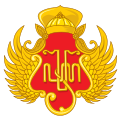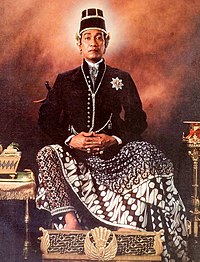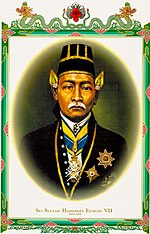Loading AI tools
Javanese monarchy in Yogyakarta Special Region, Indonesia From Wikipedia, the free encyclopedia
The Sultanate of Yogyakarta, officially the Sultanate of Ngayogyakarta Hadiningrat[9] (Javanese: ꦏꦱꦸꦭ꧀ꦠꦤ꧀ꦤꦤ꧀ꦔꦪꦺꦴꦒꦾꦏꦂꦡꦲꦢꦶꦤꦶꦔꦿꦠ꧀, romanized: Kasultanan Ngayogyakarta Hadiningrat Javanese pronunciation: [ŋajogjɔkartɔ hadinɪŋrat]; Indonesian: Kesultanan Yogyakarta) is a Javanese monarchy in Yogyakarta Special Region, in the Republic of Indonesia. The current head of the sultanate is Hamengkubuwono X.[10]
Sultanate of Ngayogyakarta Hadiningrat ꦏꦱꦸꦭ꧀ꦠꦤ꧀ꦤꦤ꧀ꦔꦪꦺꦴꦒꦾꦏꦂꦡꦲꦢꦶꦤꦶꦔꦿꦠ꧀ Transliteration of name
| |||||||||||||
|---|---|---|---|---|---|---|---|---|---|---|---|---|---|
 The realm of Yogyakarta Sultanate (green) in 1830 | |||||||||||||
| Status | Political status:
Others:
| ||||||||||||
| Capital | Yogyakarta | ||||||||||||
| Official language | Javanese | ||||||||||||
| Recognised language | Dutch (1755–1811; 1816–1942) English (1811–1816) Japanese (1942–1945) Indonesian (1945–present) | ||||||||||||
| Religion |
| ||||||||||||
| Government | Absolute monarchy (until 1945) Devolved semi-constitutional monarchy within the unitary presidential republic (from 1945) | ||||||||||||
| Sultan | |||||||||||||
• 1755–1792 | ISKS Hamengkubuwana I | ||||||||||||
• 1940–1988 | ISKS Hamengkubuwana IX | ||||||||||||
• 1989– | ISKS Hamengkubuwana X | ||||||||||||
| Pepatih Dalem | |||||||||||||
• 1755–1799 | Danureja I | ||||||||||||
• 1933–1945 | Danureja VIII | ||||||||||||
| Legislature | None | ||||||||||||
| History | |||||||||||||
| 13 February 1755 | |||||||||||||
• Status downgrade | 3 August 1950 | ||||||||||||
Website www | |||||||||||||
| |||||||||||||
| Today part of | |||||||||||||
| Sultan of Yogyakarta | |
|---|---|
| Kasultanan Ngayogyakarta Hadiningrat ꦏꦱꦸꦭ꧀ꦠꦤ꧀ꦤꦤ꧀ꦔꦪꦺꦴꦒꦾꦏꦂꦡꦲꦢꦶꦤꦶꦔꦿꦠ꧀ | |
Provincial | |
 | |
| Incumbent | |
 | |
| Hamengkubuwono X since 7 March 1989 | |
| Sultan of Yogyakarta | |
| Details | |
| Style | His Majesty [lower-alpha 3] |
| Heir presumptive | Princess Mangkubumi |
| First monarch | Sultan Hamengkubuwono I |
| Formation | 1755[8] |
| Residence | The Royal Palace of Yogyakarta |
| Appointer | Hereditary |
Yogyakarta existed as a state since 1755 on the territory of modern Indonesia in the central part of Java Island. The sultanate became the main theatre of military operations during the Java War of 1825–1830, following which a significant part of its territory was annexed by the Dutch, and the degree of autonomy was significantly curtailed. In 1946–1948, during the war of independence of Indonesia, the capital of the republic was transferred to the territory of the sultanate, in the city of Yogyakarta.
In 1950, Yogyakarta, along with the Principality of Pakualaman became part of Indonesia, with the former royal realms united as a Special Region, with status equal to that of a national province. At the same time, the hereditary titles of Sultan of Yogyakarta and Prince of Pakualaman, with ceremonial privileges carried with the titles, were legally secured for the rulers. In 2012, the Indonesian government secured an act (No. 13 of 2012) which formally recognised the reigning sultan of Yogyakarta as the hereditary governor of the Special Region of Yogyakarta, with the Pakualam Prince as its hereditary vice-governor (article 18, paragraph 1c).[11] That act also formally incorporated the sultanate as a corporation sole with the privilege of land ownership, therefore restoring the sultanate's right to own crown land (which it originally rescinded in the 1980s); as of 2019, the sultanate is claimed to own almost 10% of land in the Special Region of Yogyakarta.[12]
The sultanate is located on the southern coast of the island of Java. In the south, it is bordered by the Indian Ocean, with land surrounded by the province of Central Java. The area is 3,133 km2, while the population in 2010 was about 3.5 million people. The special district of Yogyakarta, along with Jakarta, has the largest population density among the provinces of Indonesia.[13]
Not far from the city of Yogyakarta is the volcano Merapi, the most active volcano in Indonesia which has erupted regularly since 1548, resulting in great damage to the population of the district. In October–November 2010, there was a strong volcanic eruption, forcing about a 100,000 people to temporarily leave their homes.[14][15]
After the death of Sultan Agung in 1645, the Sultanate of Mataram went into decline due to a power struggle within the sultanate itself.[16] The Dutch East India Company also exploited the power struggle to increase its control. At the peak of the conflict, the Mataram Sultanate was split into two based on the Treaty of Giyanti of 13 February 1755: Yogyakarta Sultanate and Surakarta Sunanate.[16][17][8]
The Giyanti Treaty mentioned Pangeran Mangkubumi as Sultan of Yogyakarta with the title of
ꦔꦂꦱꦢꦊꦩ꧀ꦱꦩ꧀ꦥꦺꦪꦤ꧀ꦢꦊꦩ꧀ꦲꦶꦁꦏꦁꦱꦶꦤꦸꦮꦸꦤꦏꦁꦗꦼꦁꦱꦸꦭ꧀ꦠꦤ꧀ꦲꦩꦼꦁꦏꦸꦨꦸꦮꦤꦱꦺꦤꦥꦠꦶꦲꦶꦁꦔꦭꦒꦔꦧ꧀ꦢꦸꦭ꧀ꦫꦏ꦳꧀ꦩꦤ꧀ꦱꦪꦶꦢꦶꦤ꧀ꦥꦤꦠꦒꦩꦏ꦳ꦭꦶꦥ꦳ꦠꦸꦭ꧀ꦭꦃ Ngarsa Dalem Sampeyan Dalem Ingkang Sinuwun Kangjeng Sultan Hamengkubuwana Senopati-ing-Ngalaga Ngabdulrakhman Sayyidin Panatagama Khalifatullah[lower-alpha 4]
His Highness the Sultan, Commander in the Battlefield, Servant of the Most Gracious, Cleric and Caliph that Safeguards the Religion[lower-alpha 5]
As the result of further colonial intervention within the ruling family of the former Mataram Sultanate, the area which today is the Special Region of Yogyakarta was divided into the Sultanate of Yogyakarta (Kasultanan Yogyakarta) and the Principality of Pakualam (Kadipaten Pakualaman).[17]
The Dutch colonial government arranged for the carrying out of autonomous self-government, arranged under a political contract. When Indonesian independence was proclaimed, the rulers, the sultan of Yogyakarta and the Prince of Pakualaman made a declaration supporting the newly founded Republic of Indonesia, and they would unite with the Republic. After the republic's independence was formally recognised internationally, the former royal realms were formally unified on 3 August 1950 into the Yogyakarta Special Region, with the sultan of Yogyakarta becoming the hereditary governor of the Yogyakarta Special Region and the Prince of Pakualaman becoming the hereditary vice governor of the Yogyakarta Special Region, formally on 30 August 2012 (article 18, paragraph 1c);[21] both are responsible to the president of Indonesia.[22][17]

In carrying out the local government administration, it considers three principles: decentralisation, concentration, and assistance. The provincial government carries out the responsibilities and authorities of the central government, as well as its own autonomous responsibilities and authorities. The Regional Government consists of the Head of the Region and the Legislative Assembly of the Region. Such construction guarantees good cooperation between the Head of the Region and the Legislative Assembly of the Region to achieve sound regional government administration. The Head of the Special Region of Yogyakarta has a responsibility as the Head of the Territory and is titled as a Governor.[17]
The first governor was the late Hamengkubuwono IX, Sultan of Yogyakarta, and continued Paku Alam VIII as acting governor until Hamengkubuwono X ascended in 1998.[23] Unlike the other heads of regions in Indonesia, the governor of the Special Region of Yogyakarta has the privilege or special status of not being bound to the period of position nor the requirements and way of appointment (article 25, paragraphs 1 and 2).[24] However, in carrying out their duties, they have the same authority and responsibilities.[17]
On 5 May 2015, following a royal decree issued by Hamengkubuwono X, Princess Mangkubumi (previously known as Princess Pembayun) received the new name Mangkubumi Hamemayu Hayuning Bawana Langgeng ing Mataram. This denotes her as the heiress presumptive to the sultanate.[25] The title Mangkubumi was formerly reserved for senior male princes groomed for the throne, including the reigning sultan. The decree thus admits female royalty into the line of succession for the first time since the founding of the Sultanate. According to the current sultan, this was in line with his prerogatives; his action was nonetheless criticised by more conservative male family members such as his siblings, who were thus displaced in the line of succession.[26]

The principal residence of the sultan is the kraton (palace), sometimes called the keraton but otherwise known in formal terms Keraton Ngayogyakarta Hadiningrat (Javanese script: ꦏꦫꦠꦺꦴꦤ꧀ꦔꦪꦺꦴꦒꦾꦏꦂꦡꦲꦢꦶꦤꦶꦔꦿꦠ꧀).
List of sultans of Yogyakarta:
| Name | Birth–Death | Start of reign | End of reign | Description | Portrait |
|---|---|---|---|---|---|
| Hamengkubuwono I
Raden Mas Sujana |
6 August 1717 – 4 March 1792 (aged 74) | 1755 | 1792 | Son of Amangkurat IV | |
| Hamengkubuwono II
Raden Mas Sundoro |
7 March 1750 – 3 January 1828 (aged 77) | 1792 | 1810 | Son of Hamengkubuwono I |  |
| Hamengkubuwono III
Raden Mas Surojo |
20 February 1769 – 3 November 1814 (aged 45) | 1810 | 1811 | Son of Hamengkubuwono II |  |
| Hamengkubuwono IV
Raden Mas Ibnu Jarot |
3 April 1804 – 6 December 1822 (aged 18) | 1814 | 1823 | Son of Hamengkubuwono III |  |
| Hamengkubuwono V
Raden Mas Gathot Menol |
20 August 1821 – 1855 | 1823 | 1826 | Son of Hamengkubuwono IV |  |
| Hamengkubuwono V
Raden Mas Gathot Menol |
20 August 1821 – 1855 | 1826 | 1855 | Son of Hamengkubuwono IV |  |
| Hamengkubuwono VI
Raden Mas Mustojo |
1821 – 20 July 1877 | 1855 | 1877 | Brother of Hamengkubuwono V |  |
| Hamengkubuwono VII
Raden Mas Murtejo |
1839–1931 | 1877 | 1921 | Son of Hamengkubuwono VI |  |
| Hamengkubuwono VIII
Raden Mas Sujadi |
3 March 1880 – 22 October 1939 (aged 59) | 1921 | 1939 | Son of Hamengkubuwono VII |  |
| Hamengkubuwono IX
Raden Mas Dorodjatun |
12 August 1912 – 2 October 1988 (aged 76) | 1939 | 1988 | Son of Hamengkubuwono VIII |  |
| Hamengkubuwono X
Raden Mas Herjuno Darpito |
2 April 1946 | 1988 | Current Sultan | Son of Hamengkubuwono IX |  |
Seamless Wikipedia browsing. On steroids.
Every time you click a link to Wikipedia, Wiktionary or Wikiquote in your browser's search results, it will show the modern Wikiwand interface.
Wikiwand extension is a five stars, simple, with minimum permission required to keep your browsing private, safe and transparent.